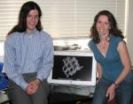New class of 'dancing' dendritic cells derived from blood monocytes
2010-11-11
(Press-News.org) Dendritic cells, known to be the prime movers of the body's immune response, are still notoriously difficult to study in humans. Samples, which come primarily from bone marrow or lymphoid tissue, are simply too difficult to obtain. But new research at Rockefeller University has shown scientists a way to study "authentic" dendritic cells from mouse monocytes, which are abundant in the blood, a much more accessible source in humans. The discovery, published Oct. 29 in Cell, promises to accelerate research into therapeutic uses of dendritic cells in people, particularly in vaccine development and cancer treatment; it comes from the lab of Ralph M. Steinman, who first published his discovery of dendritic cells in 1973.
"So much of the work has been done in mice because of the logistics of getting the dendritic cells to work with," says lead researcher Cheolho Cheong, a postdoc in the Laboratory of Cellular Physiology and Immunology at Rockefeller University. "We are filling in the gap between mice and humans with this new way to produce dendritic cells originated from the blood monocytes of living animals."
Cheong's breakthrough is in defining and isolating a new class of dendritic cells, called monocyte-derived dendritic cells, from the other types of specialized dendritic cells that reside in the lymph nodes, known as classical dendritic cells. After several years of searching, he found antibodies that would attach to a protein called DC-SIGN particular to the surface of monocyte-derived dendritic cells, a 'handle' he could biochemically grab hold of to separate out the cells. Using this tool, Cheong was able to show that monocytes, facing an infection of gram-negative bacteria such as Escherichia coli or their cell wall component called lipopolysaccharid in the blood, migrate to lymph nodes, where they quickly develop into fully fledged monocyte-derived dendritic cells, capable of stimulating T cells and fighting the infection.
When he segregated the cells and looked at them in the microscope, he saw that they had developed the unusual shape and manner of dendritic cells, with extended arms actively probing the environment for infectious particles, taking them up and presenting them to T cells. "It looks like these regular T cells are dancing with the stars," he says. The monocyte-derived dendritic cells he had discovered outnumbered the classical dendritic cells in the infected mice and appeared to be as efficacious as their relatives in presenting invading particles to T cells, although more experiments will be required to determine their exact function in the immune response.
The work contributes to an increasingly detailed picture of how dendritic cells are derived, including work published last year in Science by Steinman's colleague and former protégé Michel C. Nussenzweig. Nussenzweig and colleagues clarified the lineages of different types of dendritic cells and in particular the point at which classical dendritic cells separate from the closely related monocytes, even though they share a common ancestor in the bone marrow.
The research also shows that monocyte-derived dendritic cells are in fact "authentic" dendritic cells, with the same functional properties as their classical cousins. Although Cheong performed the work in mice, the discovery that real dendritic cells can be coaxed from blood monocytes promises to accelerate the study of dendritic cells in humans, because it is much simpler clinically to culture monocytes from a blood sample than classical dendritic cells from lymph tissues.
"If we better understand the human counterpart of monocyte-derived DCs in mice, we can design better dendritic cell-based therapeutics for human use," Cheong says.
INFORMATION:
The research was supported in part by Flancis Florio Fund for blood diseases from New York Community Trust.
END
ELSE PRESS RELEASES FROM THIS DATE:
2010-11-11
COLUMBUS, Ohio – Depression appears to be associated with a molecular-level disturbance in the body's 24-hour clock, new research suggests.
Scientists examined genes that regulate circadian rhythm in people with and without a history of depression. As a group, those with a history of depression had a higher level of activity of the so-called Clock gene, which has a role in regulating circadian rhythm, than did people with no mood disorders.
Higher expression levels of this gene suggest something is amiss in the body's 24-hour biological and behavioral cycle, which ...
2010-11-11
A stroke wreaks havoc in the brain, destroying its cells and the connections between them. Depending on its severity and location, a stroke can impact someone's life forever, affecting motor activity, speech, memories, and more.
The brain makes an attempt to rally by itself, sprouting a few new connections, called axons, that reconnect some areas of the brain. But the process is weak, and the older the brain, the poorer the repair. Still, understanding the cascade of molecular events that drive even this weak attempt could lead to developing drugs to boost and accelerate ...
2010-11-11
(Santa Barbara, Calif.) –– Beginning around 542 million years ago, a profusion of animals with shells and skeletons began to appear in the fossil record. So many life forms appeared during this time that it is often referred to as the "Cambrian Explosion."
Geologists at UC Santa Barbara and a team of co-authors have proposed a rethinking of the timeline of these early animal appearances. Their findings are published in the latest issue of the Geological Society of America Bulletin.
Charles Darwin, in his book "On the Origin of Species," was troubled by the way the fossil ...
2010-11-11
University of California, Berkeley, scientists have found a way to overcome one of the main limitations of ultrasound imaging – the poor resolution of the picture.
Everyone who has had an ultrasound, including most pregnant women, is familiar with the impressionistic nature of the images. One of the limits to the detail obtainable with sonography is the frequency of the sound: The basic laws of physics dictate that the smallest objects you can "see" are about the size of the wavelength of the sound waves. For ultrasound of deep tissues in the body, for example, the sound ...
2010-11-11
CORVALLIS, Ore. – New research has found that a mother's poor nutrition during pregnancy and nursing can cause problems for her offspring's ability to process medications, even well into adulthood.
The results of the study, by Oregon State University researchers, suggest that in the future physicians prescribing drugs ranging from Tylenol to cancer chemotherapies may need to factor birth weight along with body weight into dosing decisions for their patients.
In this laboratory study, the kidneys of underweight animals born to mothers fed low-protein diets during pregnancy ...
2010-11-11
Monash University researchers have discovered that male Australian desert goby fish are surprisingly strategic when it comes to courtship, adapting their tactics depending on the frequency of their contact with females.
Attracting females involves significant time, energy and exposure to predation and previous research has indicated that male gobies are more likely to court larger females due to the number of eggs they carry compared with their smaller counterparts.
However, new research, published in the journal Behavioral Ecology and Sociobiology, indicates that ...
2010-11-11
ST. PAUL, Minn. – Contrary to earlier research, a new, long-term study suggests that cholesterol level in mid-life may not be linked to later development of Alzheimer's disease, according to a study published in the November 10, 2010, online issue of Neurology®, the medical journal of the American Academy of Neurology. However, the results suggest that large decreases in cholesterol levels in old age could be a better predictor of developing the memory-robbing disease.
"While some studies suggest that cholesterol is a risk factor for dementia, others have not replicated ...
2010-11-11
High cholesterol levels in middle age do not appear to increase women's risk of developing Alzheimer's disease and other forms of dementia later in life, new Johns Hopkins-led research finds, despite a body of scientific evidence long suggesting a link between the two.
What the study, published online in the journal Neurology, does find is that women whose cholesterol levels decline from middle age to old age are at 2.5 times greater risk of developing the memory-wasting diseases than those whose cholesterol stayed the same or increased over the years.
"Our research ...
2010-11-11
Consumption of fructose-rich beverages, such as sugar-sweetened sodas and orange juice is associated with an increased risk of gout among women, although their contribution to the risk of gout in the population is likely modest because of the low incidence rate among women, according to a study that will appear in the November 24 print edition of JAMA. The study is being released early online to coincide with its presentation at the American College of Rheumatology annual scientific meeting.
Gout is a common and very painful inflammatory arthritis. "The increasing disease ...
2010-11-11
Atoms-for-Peace is the curious name given to a pair of interacting and merging galaxies that lie around 220 million light-years away in the constellation of Aquarius. It is also known as NGC 7252 and Arp 226 and is just bright enough to be seen by amateur astronomers as a very faint small fuzzy blob. This very deep image was produced by ESO's Wide Field Imager on the MPG/ESO 2.2-metre telescope at ESO's La Silla Observatory in Chile.
A galaxy collision is one of the most important processes influencing how our Universe evolves, and studying them reveals important clues ...
LAST 30 PRESS RELEASES:
[Press-News.org] New class of 'dancing' dendritic cells derived from blood monocytes


